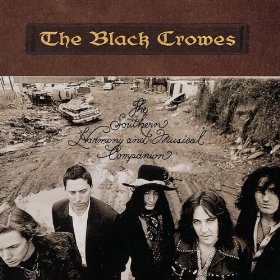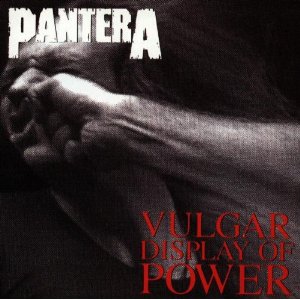bLISTerd: The Top 100 Albums of the ’90s (80-71)
by Popblerd Staff on Oct 27, 2011 • 2:45 pm 1 CommentBoyz II Men, Wilco and Queensryche can be found in our last installment, and Pavement, Erykah Badu and DJ Shadow lead us off with our first ten.
Now, on with the show!! By the time this is over, we’ll be over a quarter of the way to the top!!
It’s not said very often, but one thing that definitely contributed to the ’90s paradigm shift was the advent of Soundscan. Previously, the charts were determined not by hard sales data, but by Billboard reporters calling stores and asking them to rank what their top sellers were. All it took was a simple call from a record label asking for some titles to be switched around (bribes for tickets, free records or other perks were commonplace) and voila. That sort of trickery couldn’t be done when point of sale data was being transmitted directly to the chart compilers, and Billboard’s lists very quickly took on a different flavor – one that was less about dance-pop and hair metal and more about alternative rock and hip-hop…and Garth Brooks, who went on to become the decade’s best selling artist. Unfortunately, The Life of Chris Gaines did not make it onto our list. Ah, well…
 80. The Black Crowes | The Southern Harmony & Musical Companion (released 5/12/92 on American Recordings | 1.8 million)
80. The Black Crowes | The Southern Harmony & Musical Companion (released 5/12/92 on American Recordings | 1.8 million)
When The Black Crowes debuted with Shake Your Money Maker at the beginning of the ’90s, nobody quite sounded like them. Well, that isn’t true…popular rock bands from ’60s and ’70s like The Faces, The Rolling Stones and Aerosmith had similar styles, but The Black Crowes sounded like them as opposed to the other way around. Nobody quite seemed to know what to do with the band from a marketing perspective. MTV was spinning their cover of Otis Redding’s “Hard To Handle” on Headbanger’s Ball sandwiched between Megadeth and Exodus videos while the band was out opening for ZZ Top (and famously getting booted from the tour after vocalist Chris Robinson insulted the tour’s sponsor Miller from the stage). Nonetheless, as mercifully happens sometimes, the cream rose to the top and The Black Crowes were embraced by the rock loving public and anticipation was high for their sophomore set The Southern Harmony And Musical Companion. Taking any concerns about a sophomore slump and squashing them with a homerun of a record, The Southern Harmony And Musical Companion is arguably the band’s best effort in their discography. Featuring 4 #1 Mainstream Rock hits in “Remedy”, “Sting Me”, “Hotel Illness” and “Thorn In My Pride” and two incredible ballads in “Bad Luck Blue Eyes Goodbye” and “Sometimes Salvation”, this album was unabashedly retro rock at a time when it was not cool to be so. Multiple tracks featuring killer female back-up vocals and closing out the album with a cover of Bob Marley’s “Time Will Tell” were nice touches too. The Southern Harmony And Musical Companion is simply the sweet, sweet, sweet sounds of a singer, two guitarists, bassist, drummer and piano player cranking out some honest to goodness, blues based rock ‘n roll. This record was exceptionally cool in 1992 and will still be exceptionally cool in 2992. – Nick
79. Rage Against the Machine | Rage Against the Machine (released 11/6/92 on Epic Records | 3.6 million)
As a late-comer to the world of Rage Against the Machine (I didn’t really explore them until their final non-covers album The Battle of Los Angeles), I can only imagine how absolutely revolutionary their first album must have seemed when it hit the scene in 1992. This was a world in which both heavy rock and hip hop were firmly established, but no one had really attempted to bridge the gap with a style that mixed these two camps (at least in a serious way, if you count things like the Aerosmith/Run DMC collab “Walk This Way”). Yet in their first stab, Rage created a master’s course in a genre that didn’t even exist, an effort that has yet to be topped in almost two decades thanks to its ability to mix tight grooves, hard rock headbanging, and honest-to-god lyrics that articulate political disillusionment better than most manifestos. From the raw fist pumping energy of “Take the Power Back” and “Bombtrack” to the slow-builds of “Settle for Nothing” and “Wake Up”, the album doesn’t waste a single one of its ten tracks. And let’s not forget the classic “Killing in the Name”, with its screamable repeated mantra of “fuck you I won’t do what you tell me” which is almost guaranteed to stir a crowd into revolution. Their self-titled debut rightly holds its place among the best politically inspired albums ever.-Stephen
78. Bjork | Post (released 6/13/95 on Elektra Records | 838K)
With Debut, Bjork emerged as a solo artist not afraid to venture into mildly abstract territory while retaining mainstream sensibilities in her brand of electronic pop. Post served to show audiences that she was not simply a one trick pony. Bjork’s sophomore effort has the former Sugarcube incorporating an impressive array of styles. With nods to trip hop, industrial, and the blaring big band orchestration of “It’s Oh So Quiet” in addition to further exploring her poppier side, Post manages to succeed despite its ecclecticism, or perhaps because of it. A whopping six of the album’s 11 tracks were issued as singles, each accompanied by some of the decade’s most memorable music videos (thanks to top notch directors like Spike Jonze, Michel Gondry, Stéphane Sednaoui and John Kricfalusi of Ren and Stimpy fame). – Dr. Gonzo
77. New Radicals | Maybe You’ve Been Brainwashed, Too (released 10/20/98 on Geffen Records | 908K)
Singer Gregg Alexander’s bid to be mentioned in the same breath as acerbic pop/rock/soul luminaries as Todd Rundgren, Hall & Oates, and Joe Jackson, might’ve just worked, if the reclusive singer hadn’t disbanded his band after one record. But what a record – Brainwashed still sounds like a breath of fresh air to the face, landing as it did smack dab in a musical landscape that was definitely skewing glossy and pre-packaged. “You Get What You Give”‘s perfect piano pop may have gotten all the attention, but to reduce the album to its lone hit gives short shrift to the rest of the platter, a colorful, immaculately-sung collection of pop gems. Alexander’s Mick Jagger affectations bring “I Hope I Didn’t Just Give Away the Ending” and “Jehovah Made This Whole Joint For You” home nicely; and then there’s second single, the oft-covered “Someday We’ll Know”, the most perfect, wistful ballad the ’90s ever produced. I hold out hope that the Radicals will reform someday, but until then, we’ve got a pretty perfect pop record to tide us over. – Drew
76. Temple of the Dog | Temple of the Dog (released 4/16/91 on A&M Records | 1.9 million)
Supergroups often have a tendency to stumble, either because of a lack of chemistry or a lack of quality material. But what about a supergroup formed before any of its members were stars? Temple of the Dog was a project formed by Chris Cornell of Soundgarden as a way to memorialize his friend Andrew Wood, the frontman of glam-rock act Mother Love Bone who died of an overdose in 1990. Cornell and bandmate Matt Cameron enlisted two former members of MLB, guitarist Stone Gossard and bassist Jeff Ament, as well as newcomers Mike McCready and Eddie Vedder; the latter four were in a band first known as Mookie Blaylock and later Pearl Jam (actually, Vedder had just flown to Seattle to audition for the band). Released in April 1991, the album didn’t garner much attention, but a year later, after both Soundgarden and Pearl Jam had become star acts, A&M reissued the album and it eventually went platinum, primarily on the strength of the single and video “Hunger Strike”. Temple of the Dog was a departure from Cornell’s darker, heavier work with Soundgarden, emphasizing the more melodic riff rock that Pearl Jam would later specialize in. “Say Hello 2 Heaven” and “Call Me a Dog” are mellower tributes to Wood, while the 11-minute “Reach Down” is a guitar-solo tour de force for McCready. Not bad for a quickly recorded one-off. – Jay
 75. Tori Amos | Little Earthquakes (released 2/25/92 on Atlantic Records | 2 million)
75. Tori Amos | Little Earthquakes (released 2/25/92 on Atlantic Records | 2 million)
“What if I’m a mermaid, in these jeans of yours with her name still on it?” With those words Tori Amos thrust me full force into the alternative scene and kick started the Lilith Generation. Up to hearing those words and that song (“Silent All These Years”) I had taken tentative steps into the genre. I was a heavy metal and classic rock kid but was more than willing to listen some alternative bands as long as they maintained a male vocalist with a strong voice, a pounding rhythm and thundering guitars—Tori Amos changed all that. “Silent All These Years” was a gateway drug. It was like no pop music I had heard before. She may have looked like she came from the 70’s but the melodies she plucked and vocal choices were pure 90’s alternative. I was mesmerized by the song, picked up the album the day it came out and made sure to see Amos in concert as soon as I could. The songs on that first album were all as peculiar, arresting and as pure an art as my young head could wrap itself around. Not to mention that Little Earthquakes really did start up the whole alternative resurgence of the female singer songwriter, that Carol King in a more artsy package that became fully realized with artists like Sarah McLachlan, Jewel or Paula Cole can trace its roots or at least its public face to Tori Amos. That’s why Little Earthquakes is one of if not the most important album of the decade for me. I’m not sure I would have listened to bands like the Cure, Replacements or any other band labeled “alterna-whatever” if it hadn’t been for Ms Amos. – Dave
74. Pearl Jam | Yield (released 2/3/98 on Epic Records | 1.6 million)
After the increasingly avante-garde forays of Vitalogy and No Code, Pearl Jam returned to their straightforward rock roots on Yield, a fact proudly heralded by album opener “Brain of J” with its punk heavy (think Dead Boys) lead guitar riff. The band finds similar raw energy on “Do the Evolution”, with its tongue-in-cheek dismantling of modern society and religion (“I’m a thief, I’m a liar, here’s my church, I sing in the choir” is especially searing in its simplicity). The band even borrows from rock greats Led Zeppelin with the main riff of “Given to Fly”, a soaring anthem of over-coming adversity that ranks among the bands most affecting works. Even the simple “Wishlist” works because of the heartfelt delivery of Vedder and company. The band still finds room for some experimental weirdness is later tracks like “Red Bar” and “Push Me, Pull Me”, and the album at times seems a bit more disjointed than earlier works, thanks to this being the first truly collaborative PJ album (almost half the songs were written by members other than Vedder), but the diversity augments more than it detracts. And how can you hate an album that produced the absolutely incredible “In Hiding”?-Stephen
73. Sublime | Sublime (released 7/30/96 on Gasoline Alley/MCA Records | 6.3 million)
The success of Sublime’s self-titled album is a result of the style, passion, and demons that ultimately ended Bradley Nowell’s life. The album is a reflection on life, however. The good (“What I Got”), the bad (“April 29 1992”), the sexy (“Caress Me Down”) and the weird (“Santeria”). The album works through all the different musical styles Sublime bring –sometimes in one song (“Seed”). The best part of the record is that it clearly was not written for radio appeal (teenage pregnancy, prostitution and smoking crack…) but the songs were so damn catchy — much like their earlier oddball hit “Date Rape” — that radio couldn’t help but play the damn thing.
My Sublime t-shirt was pretty much my standard uniform through high school and this was the soundtrack. I’m feeling nostalgic just typing this… then again, the success of the album is also the reason the world has been plagued by The Long Beach Dub All-Stars. – Tom
72. Neil Young | Ragged Glory (released 9/11/90 on Warner Bros. Records | 142K post the advent of Soundscan)
Neil Young spent the ‘80s wandering from style to style, genre to genre: Classic hard rock, country, vocoder vocals, rockabilly, horn-driven blues, the man was all over the place. With 1989’s Freedom, Young seemed to get back to the Rust Never Sleeps sound that he was best known for. Ragged Glory saw Young reuniting with Crazy Horse, his grungy-before-grunge backing band, and turning the amps up to 12. The album is literally drenched with guitars, from “Mansion on the Hill” to “Farmer John” to the proto-grunge classic “Fuckin’ Up.” Young subsequently toured with Sonic Youth and Social Distortion, and later recorded with the likes of Pearl Jam. Twenty-one years later, Ragged Glory still packs a punch. – Jay
 71. Pantera | Vulgar Display of Power (released 2/25/92 on Atlantic Records | 2.2 million)
71. Pantera | Vulgar Display of Power (released 2/25/92 on Atlantic Records | 2.2 million)
After (in)famously getting started off as a teased hair and spandex wearing metal band during the ’80s, Pantera’s 1990 major label debut Cowboys From Hell showcased a band who had stopped worrying about what their stage clothes looked like, found their sound and were serious contenders to be the next big thing in metal. While thrash metal fans openly embraced Pantera, to categorize them as a thrash band is incorrect. They had a profound sense of “groove” and leaned more towards heaviness as opposed to speed and their 1992 album Vulgar Display Of Power showcases this perfectly. Definitively and unashamedly a metal band, Pantera managed to gain mainstream popularity through the sheer force of their music. Vulgar Display Of Power is in no way whatsoever a mainstream sounding album, but with the song “Walk”, Pantera began to reach beyond the metal audience and creep into the music collections of non-metalheads, situating themselves along side their Metallica and Megadeth CDs (who were both enjoying mainstream success at the time). And while Cowboys From Hell was a truly great album, Vulgar Display Of Power was the musical equivalent of skipping high school and going to college. Guitarist Diamond Darrell (soon to be known as “Dimebag” Darrell) puts on a guitar clinic of epic proportions on this album (this album alone is enough of a case for why he has been on the cover of Guitar World about 800 million times). The Ace Frehley, Eddie Van Halen lovin’ Darrell cemented his status as a GUITAR GOD with his playing here and with equally impressive performances by his brother Vinnie Paul on drums, bassist Rex Brown and vocalist Phil Anselmo, Pantera became one of the premiere heavy metal bands not only of the time, but in history. The album does pummel the listener (in the best way possible), but graciously let’s up a little bit on the almost-ballad “This Love” and album closing ballad “Hollow”. Outside of those, the listener is crushed by tracks like “Mouth For War”, “Rise”, “Live In A Hole” (love the vocoder in this one!), “Regular People (Conceit)”, “By Demons Be Driven” and the aforementioned “Walk”. In my high school and college years, I must have listened to this album hundreds upon hundreds of times. Lyrically and musically, it is an inspiring, empowering and motivating listen. It is literally impossible to sit on your ass when it is playing. Pantera would follow Vulgar Display Of Power up with Far Beyond Driven, an album that debuted at #1 on the Billboard Top 200 and, in terms of quality, does stand toe-to-toe with Vulgar, but ultimately Vulgar Display Of Power is Pantera’s defining, crowning achievement and the influence it has had on countless metal bands is immeasurable. Like another one of the records I’ve written about for this list, it is not only one of the Top 100 Albums of the ’90s, but one of the Top 100 Albums of All-Time. – Nick


1 comment
bLISTerd: The Top 100 Albums of the '90s (60-51) | Popblerd!! says:
Oct 29, 2011
[…] first, let’s backtrack: check out the sixties, seventies, eighties and […]